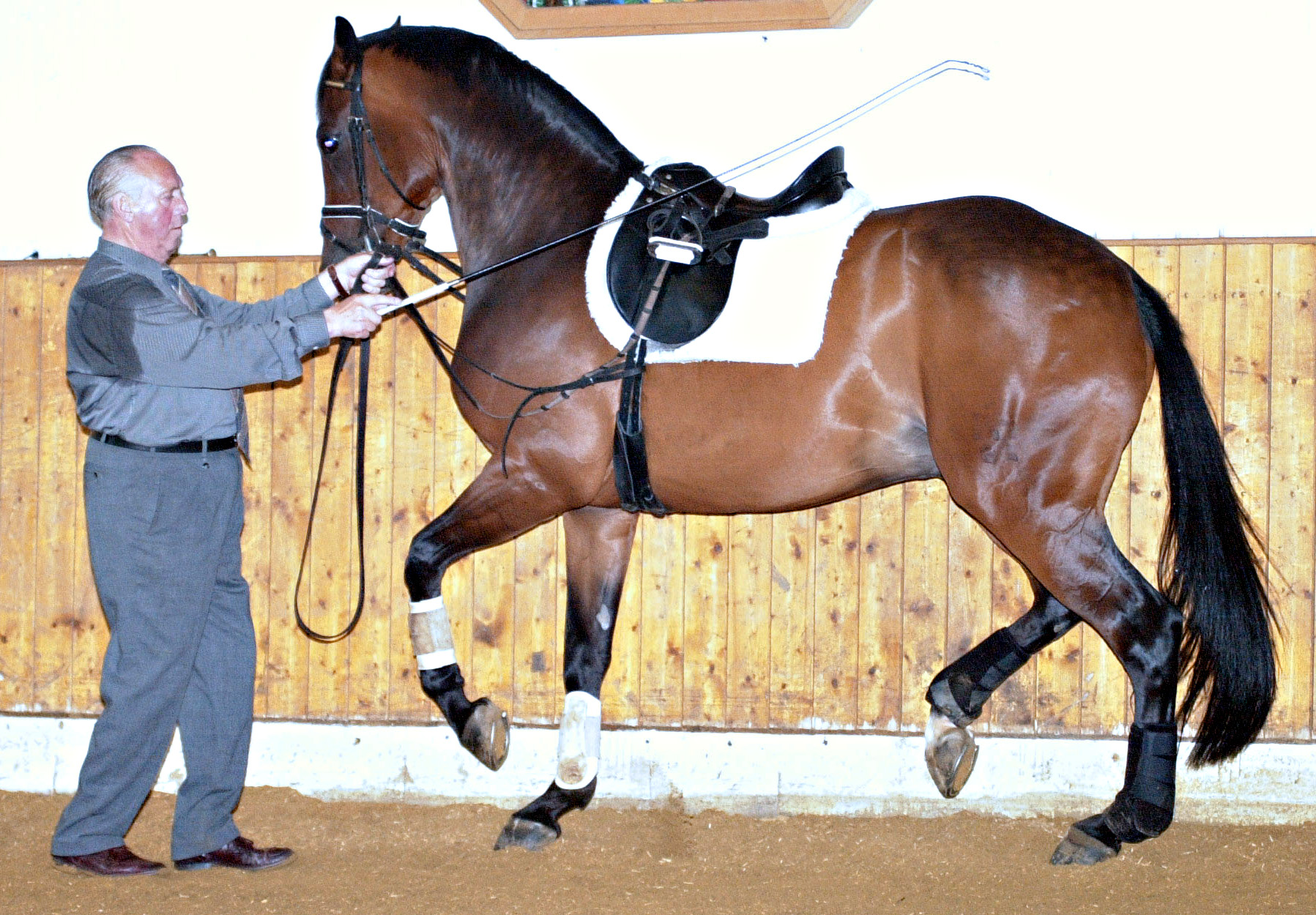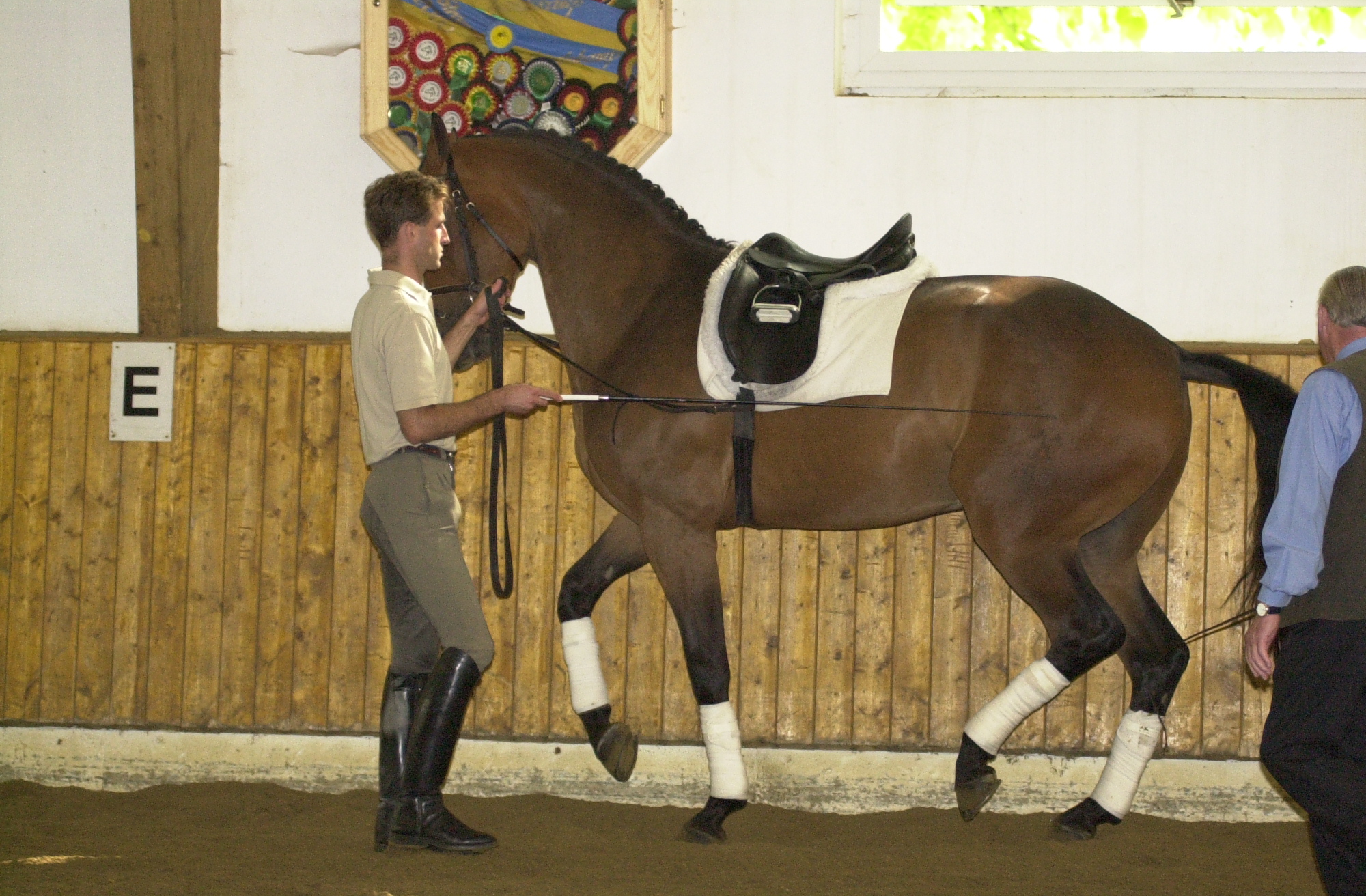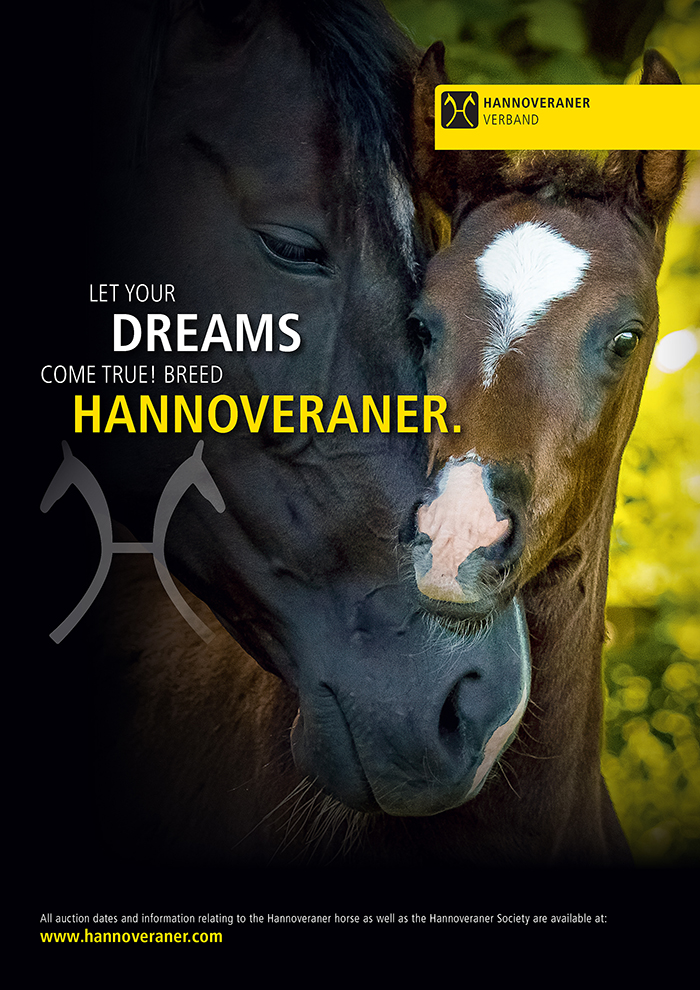 Story by Chris Hector and photos by Roz Neave
Story by Chris Hector and photos by Roz Neave
Franz Kukuk died in 2005 at the age of 77. Before he died I was lucky to watch this exceptional horseman at work at the PSI dressage stables in Hagen. It was a rare privilege…
There’s magic in the air, magic that makes an old man dance his way around the indoor, teaching young horses an art as old as horsemanship. Herr Kukuk is 74 years young, for sixty years he has worked with horses, 51 of them at the Westfalien State Stud, and now at Ulrich Kasselmann’s PSI dressage stables he combines his years of experience with an enthusiasm that is as fresh as the new day.
Herr Kukuk is teaching the four-year-old horses short steps, the beginnings of piaffe, in hand. His key words are ‘patience’ and ‘trust’, but in truth I feel it demonstrates that the most important task of the trainer is to make the request reasonable and clear, and offer the horse a comfort zone once it is doing what is asked. Step out of the comfort zone and you might get a short sharp smack, move back in the zone and the pressure is off. It is interesting that the horses that have worked the most with Mr Kukuk are the calmest, they have been here before, they know what is expected – but what they give is entirely unexpected. Herr Kukuk gently strokes one of his whips over the rump of a four year old Donnerhall/Rubinstein gelding and he starts the most brilliant piaffe…
“This horse finds the work so effortless, look how easily he goes into the hand, and how he is never afraid of the stick, it is just an aid, never a punishment. This horse has the quality of elasticity, the piaffe is so easy, so relaxed and so perfect in itself. It is so hard with horses like this that have the willingness to come back and do the piaffe on the spot, you must force yourself with a four year old to make the piaffe go forward all the time, because one day’s work can ruin it all, one day when you asked too much. It would be a sin to do something wrong with a horse like this that is so willing and so perfect, if you do anything wrong, if you over-do it, then that will remain with the horse for life. He must be gently led on.”
It is another of the paradoxes of Ulrich Kasselmann that he runs the most slick up-to date selling barn in the world, complete with CD ROMs of his auction horses in motion, yet turns to genuine old masters for his trainers. Herr Kukuk’s predecessor was General Stenken, who retired in his mid-eighties, but who even now carefully quizzes his young successor about the progress of the horses. “I like older trainers,” says Mr Kasselmann, “they have patience and time, the younger trainers are sometimes too much in a hurry to get there.”
Our helper during the working session with Mr Kukuk, was Steffi Rexrodt, a charming South African event rider who discovered a love for dressage at the Kasselmann stables six years ago, and has been there ever since. Thanks to translation and commentary, Mr Kukuk’s techniques and philosophy are so much easier to understand.
Steffi: “With this horse with a lot of blood, the important thing is to get his trust so that he doesn’t over-react, so he learns to wait to do his work, and doesn’t drag his leader around. That is the most important thing when you start with a four year old, to teach them to stay with the leader, the person who has the rein in their hand. The horse must go into the hand, but never go past the person who is leading them. They learn not to run into the hand and hurt themselves, run backwards, or sideways, just concentrate on the leader. It is like a rhythm stick in front of them, and the horse says, ‘okay, I can balance on him by just visual contact’. Once they get that, you can see the horse concentrating on their leader and going into the hand with trust.”
“They start by going in a circle, as if you are lunging. On the circle, take the whip – which unfortunately the horses see as a punishment, no horse likes the look of the whip – and just touch the quarters, or touch the hind leg, so they learn to pick up their leg at the touch. If the horse charges through the handler, they stop, they pat him, until he is fine. You would be amazed how quickly the horses calm down. They overreact all the time at the beginning, and you just have to hold them, they are like little whippets, running all over the place. Some of the horses are bloody strong and overwilling, so we’ll use a different bit, a little sharper so the horse has respect.”


“Sometimes we will work with older horses to get them back again. This horse is a ten year old Rubinstein gelding. He started off with Mr Kukuk but he was sold and has been away for many years and he has just come back – and Mr Kukuk is starting to get the refinement back in again.”
Herr Kukuk: “These steps are very good because the horse has begun to wait. The most important thing is trust to the leader so he goes into the hand without being scared. With a new horse, you always have to feel – like a raw egg – how far you can push.”
Steffi: “It’s incredible, Mr Kukuk never gives up. You think with some of the young ones this will never work, and he goes on and on until he gets some steps. ‘Good boy’. Pat. And when they led them out, they are not crazy or frightened, they are happy and relaxed, they have worked.”
“He never punishes them, he just keeps going until they are ready to wait, and be worked. The horses enjoy coming down here.”
“Once they calm down, and relax, then the work is just brilliant.”
“The horses should always leave the work with Mr Kukuk being totally calm. They should never walk out of here frightened, because obviously the next time they come down here, they will be frightened again, then it will be harder to work with them. Once they lose their confidence and trust, then you can’t get good work from the horses. On the other hand, if the horse is not working, then he might get a whack, but they don’t get a fright. Some might kick out, then they get another whack, then they are calm and they really listen.”
Mr Kukuk: “Before we work each horse, take a break long enough to make sure everything is right. The side rein should be as long as possible, so that when I ask them to step forward, the contact doesn’t hit the side-rein, that you really have the horse’s mouth on your hand. Then I go onto a circle and try to find the horse’s own rhythm and take hold of that, and see if they will react to the touch of the whip on the inside hind leg – they must be prepared to bring it up when I touch them, but keeping the rhythm. The eye of the holder is most important, you must watch the horse’s rhythm. The handler must really know the sequence of the horse’s steps, must see that the whole of the horse is in its own flow, and you are not interrupting that- and out of that flow, maybe get three steps. The sequence of the steps is diagonal and if you use the stick in the right sequence, you already have a tiny way forward to the piaffe. When they are first starting then we only do two rounds of the circle, with just one handler, and then they are finished, they can go home. They don’t go straight onto the wall. This horse has only been here two times.”

“If the horse starts to run away, pat it and take it on a small circle until it relaxes.
Steffi explains that the horses do not come into the in hand session ‘cold’.
“We always work the horses before they come into these sessions. On Monday mornings, because they are coming to do the in hand work, so you give them a nice long warmup so the horse is really flexible, twenty to thirty minutes, then bring them here. After they work here, then they rest. It would be too hard on the four-year olds to work them after this. They get worked like this every Monday, then on Thursdays, Mr Kukuk comes and teaches us, just riding on the horses normally. Then with some of the five year olds, or the very talented four year olds, he helps by schooling you on the horse.”
Mr Kukuk: “It is very important to teach the horse this when he is young, to let him find his rhythm, otherwise he’ll have little mistakes that get worse and worse when he gets older so that by the time he gets to Grand Prix, you can never rectify the mistakes. The horse must close and bend, with his hocks getting really low, and he must learn to use his legs in diagonal pairs. Every horse is an individual, if you overwork a horse, then he will never trust you. Even with the older horses, it is more comfortable for them to learn like this, without a rider.”
“You can see how the horses that have been worked like this a couple of times, they are willing to work, they don’t have to be pushed into it. They want to do it.”
“See when I get perfect steps, everything is there: rhythm, diagonality, the hocks are down. That is perfect.”
Steffi: “Some horses try too hard. They know what they have to do, but they get overanxious, ‘I can do it, I can do it’, and then they lose their diagonality and rhythm, when you get it right, then stop.”
And stop they do, absolutely dead square every time. How does he do that?
Steffi: “It’s not so much a training thing, it is when he halts them to make them stand and pat them, they always have to stand square, he always corrects them if they are resting a leg or something. He corrects them with the whip. It is such a help when you are riding the young horses, when you go to ride trot/halt, they know what it is all about.”
With the rider on the horse, Mr Kukuk would get the piaffe steps and then ask the rider to let the horse out into an extended trot.
Steffi: “We don’t just do this very collected work and then come to a total halt. Get one more extended trot out of the horse, and then let them stretch and relax. It involves a lot of hyper muscle concentration.”
“With a young horse, to teach a good passage, you need a good rider on top, who knows when the horse is in front of him or her, you can’t do everything from the ground. To help with the front end action, you must have the horse so trusting that you can run up to them, and touch the front legs with the whip, without the horse being scared. They have to trust you to do this kind of work. You can see when Mr Kukuk uses the stick on the forearms, how much more expressive the work becomes.”

Mr Kukuk’s enthusiasm never waned, each new horse presented a new challenge, and when he got the result, his joy was obvious:
“See this horse, it is like a gazelle. It’s like dancing with a woman, it is so much easier when you have a lady who is not even touching the floor, that’s how it should be. This horse is a good dancer.”
“It is very important to always take this whole rhythm in the forward movement – not blocking them, keep them moving forward, never backwards. I guarantee that in four or five times, with the rider sitting on the horse, which makes it easier because the rider can concentrate on keeping the horse straight, and I can concentrate on the legs, I will get at least five or six brilliant steps.”
Steffi: “Here with a five year old horse that has had more work with Mr Kukuk you see the horse settle down, and get into the work much quicker. You notice the springiness of the hocks.”
“Mr Kukuk always says that the most important thing you have to watch when a horse is doing in hand work, is what he calls ‘the trousers’, it is that little diamond shaped muscle above the hock, if you see that relaxing and playing, then you know that the movement is coming forward. That is the most important area to watch.”
And what was it like to ride a horse after it had a little tune with Mr Kukuk?
According to Steffi, “It’s good, when you come with your leg there is more response, they don’t run off or anything, they just go ‘ok I know what you mean’. The nice thing about doing this work on a Monday is that the horses stay finely tuned for the week. It’s not as if come Friday you are desperately waiting for Monday to come again… where’s Mr Kukuk when you need him. But you do feel the difference and the horses that have been worked quite a lot, you feel how much easier it is to work with them. If you want them to halt electric, and really stand square, you notice that they know what they are doing.”
The last words belong to Mr Kukuk: “I have been working with horses for sixty years, and the older I get, and the more I learn the more I realise the most important word is patience.”
Herr Kukuk, a life with horses…
“When I went to Warendorf, luckily I was talented, and I had a very good trainer, and he made sure that I was allowed to go to the Spanish Riding School in Vienna. In Vienna they were very surprised, when they asked me what I would like to learn there, I said ‘everything’. The apprentices who come to Vienna, have two hours, one hour being on the lunge, and the second one with the tra1ner on the floor. But I wanted more, so I went to Colonel Podhajsky, and he gave me a five-year-old Lipizzaner stallion, which I was allowed to work, and also to ride in the public performances Through that I came to the in hand work. I was lucky enough to have the full support of the head trainer, and I was able to ride everything, levades, all the movements. Sometimes you sit back and ask yourself ‘what is the most beautiful to ride, is it the piaffe, is it the levade, is it the capriole? I don’t know, I was just lucky to be able to ride all those movements, and they were very nice, they said I didn’t have to pay the pupil’s fees.”
“I took all that experience back to Warendorf, and straight away started with the work in hand and people heard and came to watch and saw that it was a very successful way to teach the horse. I also learned to work with the two long reins, and have demonstrated that technique many times. There is only one big difference between here and Vienna – they do the work with the Lipizzaners, we work with our big Warmbloods. I was very proud, they asked me back to Vienna to accept a Master’s Degree.”
I asked Mr Kukuk if work in hand was a dying art?
“Definitely not, thanks to the Kasselmann yard, this art keeps going because all these young and beautiful horses get trained in this way and this is seen not only by the riders here, but also by trainers from all over the world who come here to buy horses. It is so important that we still have this art.”
“When teaching the work in hand, people are individuals like horses, it is very hard for some people to stay relaxed, and upright, and supple when they go backwards I have taught Johannes, the young man who works here, everything, and he can do it to perfection, and now I am training another young man. It doesn’t have to be a man, females can do it as well.”
This article first appeared in the March 2001 issue of THM.
For more from Mr Kukuk, go to:


